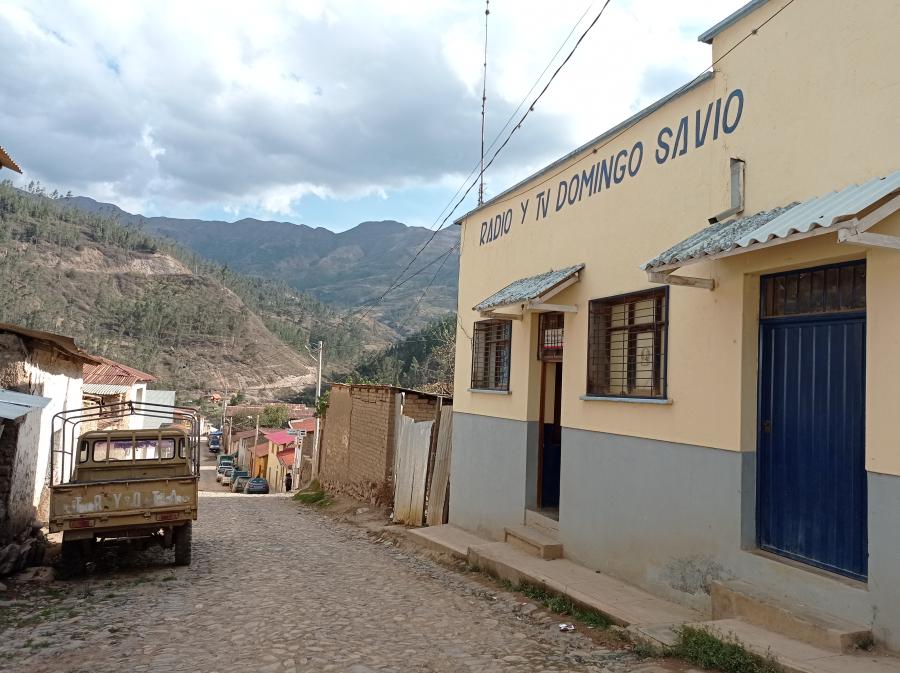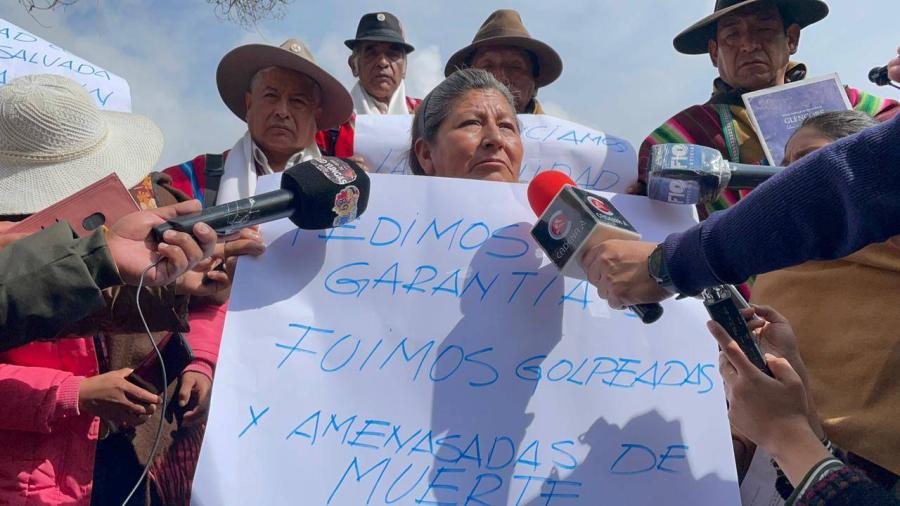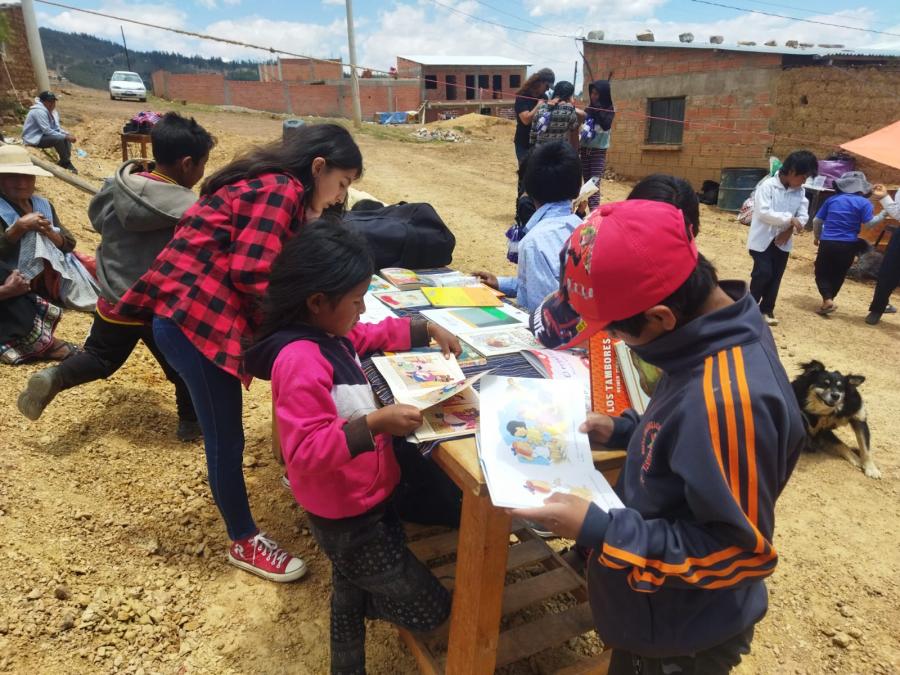Recent years, especially in the last decade, have seen increasing indigenous involvement in the national political life of Bolivia. As in many other countries of Latin America, indigenous peoples have begun to make their voices heard. This is especially significant in Bolivia where the majority of the population, 57%, is indigenous.
Changes in the State
The discursive position of the State with respect to indigenous peoples has changed radically, moving away from homogenizing conceptions and the negation of the cultural and linguistic uniqueness of indigenous cultures to a perspective more respectful of difference. This shift is being demonstrated in new laws, programs, and the official conformation of a "multiethnic" State. The State now seeks "Unity in Diversity," as a large billboard announces on the highway leading from the El Alto airport to the center of La Paz. According to the Vice President of the Republic, "democracy must be multiethnic and pluricultural if it is to be a true democracy." Ethnic pluralism is being converted into an enriching factor for the idea of the "State," for the notion of democracy itself, and a challenge for any proposals of change. A number of State officials at the highest levels, above all in the most recent government, have taken heed of these multiethnic debates which were initiated in various sectors of civil society dating from the 1980s.
Attention to indigenous demands has been increasing within the executive and legislative powers during the last two governments (1989-1993 and 1993-1997). The National Constitution was modified in 1994 to recognize the role of indigenous organizations in planning national and local policies, to redistribute public resources at the municipal level, to establish direct relations between the State and indigenous peoples, without intermediaries, and to recognize the right to indigenous language education. By the same token, for the first time an Aymara has been elected Vice President of the country. In the most recent municipal elections, 25% of the mayors and municipal council members in the country were Indians or peasants (campesinos). In addition, the indigenous presence has increased significantly in the different ministries and secretariats of the State especially in the National Secretariat of Popular Participation, the Secretariat of Ethnic, Gender, and Generational Affairs, and the Secretariat of Education. In fact, for certain political, technical, and public administration positions, being indigenous, especially if one speaks the relevant language, has changed from an identity once denied to a value added.
At the international level, Bolivia promoted the creation of a Fund for the Development of the Indigenous Peoples and actively participated with indigenous representatives in international forums where the States are often only represented by delegations from their respective governments. The government of Bolivia became, in a sense, a spokesperson in international forums for indigenous participation within a "tripartite" negotiation composed of governments, indigenous organizations, and international aid organizations. Within these events and processes, a number of tensions become apparent between the different actors involved, particularly between governments and representatives of indigenous organizations.
At the local level, thanks to the Law of Popular Participation in 1994, the inclusion of indigenous organizations has been recognized in the so-called "Territorial Base Organizations" or OTBs. This was conceived as a generic name for indigenous organizations or tëta and ayllu, neighborhood organizations called juntas vecinales, as well as union organizations, or centrales campesinos, representing the multiple social movements existing in the country. OTBs were rejected by some peoples for the confusions that this renaming generated. According to the law, the local organizations have the right to participate directly in the planning and evaluation of operative budgets in their respective municipal jurisdictions through a new agency called the Comité de Vigilancia, an oversight com-mittee chosen by the OTB. In addition, Indigenous Municipal Districts have been formed, although at present, their number is still insignificant. The redistribution of power at the local level immediately threatened the interests of many who traditionally used politics to legitimate their abuse and exploitation of indigenous peoples. As a result, some indigenous leaders have recently gained more access to congressional representatives and government authorities than the traditional local landlords or politicians. Hence, the national public was made aware of the conditions of semi-slavery in which some Guaraní groups still lived.
Of the latest legislative changes that consider ethnic pluralism, the Educational Reform Law also deserves mention. This law, passed before Popular Participation, "re-dignifies" indigenous languages, recognizing and promoting their use and revitalization. This law also recognizes the indigenous right to participate in the formation of educational policies responding to the historical projects and goals of their respective peoples in the form of National Educational Councils for the Guaraní Quechua, Aymara, and the multiethnic Amazon. Only the Educational Reform Law establishes institutions of this nature, given that the other laws concentrate on the local and municipal levels In fact, the changes within the State have been contradictory and full of internal conflicts between various national ministries and the different levels of public administration (governors, municipalities, etc.).
In economic terms, indigenous participation has been possible, for the most part, thanks to international economic support (donations and loans). The principal programs and projects involving indigenous peoples and their organizations receive very few resources from the national treasury.
Changes in the Indigenous Movement
The indigenous peasants of Bolivia have had a number of glorious roles in Bolivian history during and after the Revolution of 1952. In that era, the people achieved the universal vote, the right to education, and agrarian reform. It was, nonetheless, a peasantry that defended its class interests more than its sociocultural identity. With few exceptions, the Andean indigenous peoples organized themselves into `syndicates' or peasant unions. This became a socio-organizational structure that extends almost throughout the entire country, lending to both conflictive and harmonious processes with government authorities and more traditional social structures, like ayllus, mallkus, etc. In the case of Amazonian Indians, the organization took the form of a non-traditional Confederación Indígena del Oriente Boliviano, CIDOB, but assumed its ethnic identity as a dynamic catalyst for social mobilization.
As the indigenous movement has become popular, Andean peoples have also promoted the defense of their own cultural and linguistic uniqueness, but refuse the term "indigenous." They prefer to call themselves "original peoples" or originarios, while the peasant union structure is maintained. Evidently, we are speaking m broad generalizations, since in reality the context is not so simple. For example, in the Andes, there are also local organizations which follow the older traditional structures of ayllus. In addition, many Amazonian indigenous organizations recognize themselves in relation to the socio-political administration of the country, rather than to their particular group or ethnic groups [for example, the Indigenous Peoples' Central of Beni].
The attempts to unify the indigenous and peasant movement in the creation of an Assembly of Nationalities at the end of the 1980s did not have much success. An Andean Peasant Confederation or CSUTCB (Confederación Sindical Unica de Trabajadores Campesinos de Bolivia), principally represents the Aymara and Quechua Andean peoples, while CIDOB represents indigenous peoples of the eastern part of the country, the Amazon Basin, and the Chaco. With the exception of a few "hot" moments in the national political scene, the relations between these two confederations are not conflictive or exclusionary. In national terms, their representation corresponds to two large and different geographic regions of the country. In fact, there is much more coordination and dialogue between these two sectors now than in the 1980s.
At the national level, the CSUTCB has always been politically closer to the class-based demands of the Bolivian Workers' Central or COB (Central Obrera Boliviana), maintaining a militant oppositional attitude to the various governments. On the other hand, CIDOB has demonstrated a greater capacity to negotiate with the State, has assumed pragmatic attitudes, and has earned more prestige in the national public opinion. All of this has occurred relatively rapidly since the "March for Territory and Dignity" in 1990, when the indigenous people of the eastern lowlands entered into national political life. Before this, they were never taken into consideration, not even by the CSUTCB. They were "like little brothers that had to be taken by the hand," one Andean peasant leader commented.
The most serious problems of representation arise at the local level. Taking advantage of the legislative advances and internal contradictions in indigenous communities, some familiar powers [NGOs and local elite], with or without purely financial motives, promote the formation and recognition of OTBs or other representative bodies parallel to and in conflict with those already in existence. Indigenous communities are again redefining their strategies for participation, either in positions of local public power, or through the "official" means of social control. In other words, it was necessary to decide whether the goal was to aim for indigenous mayors and council members, or to work for spaces through the OTBs and the oversight committees. Another major decision tied to this was what role traditional indigenous authorities should play (for example, as mayor, or as leader of the OTB). However "pluri-[cultural]" the new Laws of Popular Participation are, they establish new norms and procedures which are often incompatible with traditional practices and customs. On the other hand, these new dynamics also revealed existing tensions in indigenous organizations between leaders and grassroots communities.
Relationships have changed between the State and the indigenous organizations, and between the communities themselves and the indigenous organizations. Recent years have seen the mobilization of indigenous communities, their leaders, men and women, younger and traditional, from one workshop, or taller to another. Everyone is having workshops: the ministries of state, the organizations themselves, the governors, the mayors, the international aid organizations, the NGOs. "So many workshops are making us dizzy," one Amazonian leader commented. In fact, many times these workshops are not well planned and are repeated, duplicated, and overlapping. There have been workshops to discuss laws, to analyze their implications, and to do "participatory planning," etc. These workshops are now the privileged sites for information exchange and interethnic communication. These encounters have improved the dialogue between indigenous leaders and local authorities, between traditional and more formal leaders, and between the leadership and the communities. These are also new sites where internal conflicts and tensions are confronted.
Elements of Tension
With all of these advances, there are still a number of points of tension in State/Indian relations. In official cultural debates, the position of an Aymara Vice President of the country is still a minority one in the government coalition. There are also a number conflicts with the mobilization and demands of indigenous people. For example, a violent conflict occurred in the last tinku, or ritual battle of the Ayllus of Macha, in northern Potosí, whose participants were dispersed with tear gas by the armed forces. [Also, in December, 1996, Bolivian troops killed ten Quechua miners in Amayapampa and violent conflicts with coca growers continue in the Chapare].
Tension also arises due to the lack of correspondence between the political administrative boundaries of the State, and the social and ethnic organizations at the local level. As Bolivian anthropologist Ricardo Calla suggests, "even the most honest promoters of the Law of Popular Participation persist in...non-indigenous forms of State and social administration-[such as] the municipality, governors, provinces, counties-without even adapting them seriously to indigenous forms of management of space and authority." These tensions are manifest in both the Amazon and the Chaco regions. The Guarani are divided into three departments (State administrative units), and there are no State or official provisions that account for their unity as a people in this situation. If indeed the Law of Popular Participation foresees the conformation of community organizations and indigenous jurisdiction in the municipal levels, these possibilities are restricted between district and State boundaries. The conformation and official recognition of supra-communal indigenous organizations is not possible when these cross State and county limits. Nor have there been solutions suggested for those indigenous groups who do not inhabit contiguous territories.
Because of the different situations and the possibilities for corruption or the "democratization of vice" of public administration, the national State controls the limits of this local power. For example, at the municipal level, the annual budgets must respect priorities established at the regional level, in terms of spending and in percentages assigned in budgets. Autonomy is thus limited by the fact that more power is simply given to execute what others have established: not to let indigenous peoples use the power to construct development from their own perspective, priorities, and for their organizations.
The relationship between the State and indigenous peoples is also a relationship between indigenous people and political parties. The channels for exercising public power have been, and continue to be, the traditional political parties that are nonetheless beginning to nominate indigenous representatives as party candidates. There is still no other way of running for office unless an indigenous organization wants to become a political party-a very unlikely and expensive proposition. For elections at the local level, negotiations between political parties and indigenous organizations have been fairly pragmatic, as both look for positions of power without coherent ideological agendas. Nonetheless, as CIDOB leader Marcial Fabricano was named the Vice Presidential candidate to the Free Bolivian Movement (FBM) party, there were immediately signs of disagreement on the part of other indigenous leaders within the same Confederation. The candidacy of the current Aymara Vice President occurred in a completely different context, himself having been the leader of a Katarista [ethnic Aymara] political party.
Another factor in the relationship between the State and indigenous peoples is cooperation involving both national and international aid. In theory, the Law of Popular Participation permits a direct relationship between the State and indigenous peoples, even if only at the municipal level. In reality, it does not occur this way. The power of the international aid organizations, including the churches, NGOs, and multilateral agencies and banks, is often another element of imbalance and tension. In addition, State policy changes and programs promoting indigenous participation were mainly financed more by international, rather than national, funds. This is not surprising in a highly dependent country like Bolivia.
Final considerations
In Bolivia, the relationship between the State and Indigenous peoples has been much improved in recent years. Never before have indigenous peoples been able to make their demands heard and participate in decision making. Nonetheless, there are still many sources of contention and contradiction that are not merely derived from ill will or conflicts of interest. The Minister of Popular Participation, Carlos Hugo Molina, has said on various occasions that this path of decentralization was the only possibility to hand over more power and opportunities to local organizations in the short term. Breaking or redrawing the boundaries of political administrative units would have required a long process of constitutional reform. On the other hand, neither the indigenous and peasant organizations, nor the anthropologists working for the government, have a completely clear idea about what the construction of a "multiethnic State" implies. And as always, there are not always clear answers in such a diverse country as Bolivia. Unfortunately, events in far away countries like the former Yugoslavia were phantoms which slowed the most progressive proposals. Nonetheless, there have been gains that appear to be irreversible, and others that may be subject to the changes in government which are likely to occur after elections in June 1997.
Bibliography
Albo, Xavier. 1995. Bolivia plurilingü: guía para planificadores y educadores. 2 vols. La Paz: CIPCA/UNICEF
____________.1993. Y de Kataristas a MNRistas? La soprendente y audaz alianza entre aymaras y neoliberales en Bolivia. La Paz: CEDOIN/UNITAS.
Calla, Ricardo. 1994. "Prologue." In Ayluu Sarta Ani: Perspectivas de decentralization en Karankas: la vision comunaria. La Paz: [ILDIS/PROADE.
____________,José Pinelo, and Miguel Urioste. 1989. CSUTCB: Debates sobre documentos políticos y asamblea de nacionalidades. La Paz: CEDLA.
Cardenas, Victor Hugo. 1996. "Palabras de apertura de seminario." Iturralde, Bolivia.
Contreras, Alex. 1991. Etapa de una larga marcha. Aqul, Avances, y Erbol. La Paz.
ILDIS. 1993. Lo pluri-multi o el reino de la diversidad. La Paz: ILDIS.
Molina, Sergio, and Ivan Arias. 1996. De la nación clandestina a la participación popular. La Paz: CEDOIN.
Platt, Tristan, and Concepción Gavira. 1996. "?Un caso de etnocidio estatal? Gasificando" en Macha a los Guerreros de Alba. Presencia (La Paz). May 19, 1996.
Ticona, Esteban, Gonzalo Rojas, and Xaviera Albo. 1995. Votos y wiphalas: Campesinos y pueblos originarios en democracia. La Paz: CIPCA.
Toranzo Roca, Carlos, ed. 1992. Diversidad étnica y cultural. La Paz: ILDIS.
Article copyright Cultural Survival, Inc.



